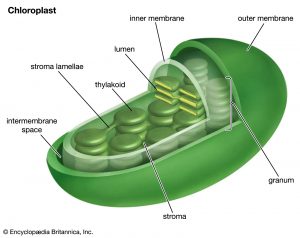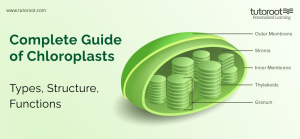Complete Guide of Chloroplasts – Function, Structure
Chloroplasts are remarkable organelles found in plant cells that play a crucial role in the process of photosynthesis. They are responsible for converting sunlight into chemical energy, enabling plants to produce their own food. In this comprehensive guide, we will explore the structure, functions, types, and significance of chloroplasts in detail.
Introduction
Chloroplasts are vital organelles found in plant cells that play a crucial role in photosynthesis. They are responsible for converting sunlight, water, and carbon dioxide into glucose, the primary source of energy for plants. In this article, we will explore the structure and functions of chloroplasts, and their types, and answer some commonly asked questions about them.
Chloroplasts Diagram
The Structure and diagram for Chloroplasts are shown below,

What are Chloroplasts? What is the origin of chloroplasts?
Chloroplasts are double-membrane-bound organelles found in the cells of green plants, algae, and some protists. They contain a pigment called chlorophyll, which gives them their characteristic green color. Chloroplasts are considered the powerhouses of plant cells, as they capture sunlight and use it to produce energy-rich molecules.
Origin of chloroplast
TO understand the origin of chloroplasts, we must also know about cyanobacteria. Chloroplast evolutionarily was born out of a primitive cyanobacteria that was surrounded by non-photosynthetic cells and, progressively, after shedding its DNA significantly, took the form of the actual chloroplast. This only holds a miniscule portion of the primary cyanobacterial genes.
Chloroplast location
Chloroplast in a plant cell is located in its cytoplasm. The exact chloroplast location can be pinned in mesophyll cells, between the upper and lower epidermis of leaves.
Importance in Photosynthesis
Photosynthesis is the process by which plants, algae, and some bacteria convert sunlight, carbon dioxide, and water into glucose and oxygen. Chloroplasts in plant cells are the primary sites where this process occurs. They contain specialized structures and pigments that enable the capture, absorption, and conversion of light energy into chemical energy.

Structure of Chloroplasts
Chloroplasts have a complex internal structure that supports their functions in photosynthesis. The key components of a chloroplast in plant cells include the outer membrane, inner membrane, thylakoid membrane system, and stroma.
Outer Membrane
The outer membrane is the outermost layer of the chloroplast, serving as a protective barrier. It regulates the movement of molecules in and out of the chloroplast.
Inner Membrane
The inner membrane is located beneath the outer membrane and plays a role in controlling the exchange of molecules between the chloroplast and the cytoplasm of the cell.
Thylakoid Membrane
The thylakoid membrane system is a network of interconnected membrane sacs called thylakoids. These membranes contain chlorophyll and other pigments, as well as protein complexes involved in light absorption and electron transport during photosynthesis.
Stroma
The stroma is the fluid-filled space surrounding the thylakoid membranes. It contains enzymes and other molecules necessary for the synthesis of carbohydrates and other organic compounds during photosynthesis.
Functions of Chloroplasts
Chloroplasts in plant cells perform several essential functions in plants, which are crucial for their growth, development, and survival.
Photosynthesis
The primary function of chloroplasts in plant cells is to carry out photosynthesis. They capture light energy from the sun and convert it into chemical energy, which is stored in the form of glucose and other carbohydrates. This process provides the energy necessary for plant growth and metabolism.
Synthesis of Starch and Lipids
Chloroplasts are involved in the synthesis of starch, a carbohydrate storage molecule, during photosynthesis. They also contribute to the production of lipids, such as fats and oils, which are important for energy storage and membrane structure in plant cells.
Production of Plant Pigments
Chloroplasts contain various pigments, including chlorophylls and carotenoids, which absorb different wavelengths of light. These pigments play a crucial role in capturing light energy for photosynthesis and protecting the chloroplast from excessive light damage.
Chloroplasts types
Chloroplasts types can be documented based on their size and shape, and depending on the plant species. Different chloroplast types can be found mostly in leaves, but they can also exist in other green parts of the plant, such as stems and immature fruits.
Chloroplasts types can be categorized into two main types based on their structural organization and location within the chloroplast.
Grana
Grana are stacks of thylakoid membranes interconnected by stroma lamellae. They are responsible for capturing light energy and facilitating the conversion of light energy into chemical energy during photosynthesis.
Stroma Lamellae
Stroma lamellae are unstacked thylakoid membranes that connect different grana stacks. They provide additional surface area for light absorption and electron transport reactions.
Conclusion
The origin of chloroplasts is fascinating, and so is the chloroplast location that is so strategically set to ensure the effective discharge of its primary function. In summary, chloroplasts in plant cells are amazing organelles that play a critical role in the process of photosynthesis, enabling plants to convert sunlight into chemical energy. Their complex structure and functions make them indispensable for plant growth, metabolism, and the maintenance of ecological balance. By understanding the significance of chloroplasts, we can gain a deeper appreciation for the vital role they play in sustaining life on Earth.
This article on chloroplasts provides a comprehensive guide covering structure, functions, types, and significance in photosynthesis. It is written in a manner that is easy to understand for 8th-grade students, allowing them to grasp the fundamental concepts of chloroplasts and their role in plant biology.
We hope that our articles have answered all your questions and brought in more knowledge. Tutoroot is an educational institution that offers online, interactive classes. Click here to book a free demo of our live interactive sessions for NEET online tuition and various message boards.
FAQs
Why are chloroplasts in plant cells green?
Chloroplasts appear green due to the presence of chlorophyll, a green pigment that absorbs light energy primarily in the blue and red parts of the electromagnetic spectrum. Chlorophyll reflects green light, giving chloroplasts their characteristic color.
Which plant cells have chloroplasts?
Chloroplasts are predominantly found in the cells of green plant tissues, including leaves, stems, and fruits that are not ripe. These cells are responsible for carrying out photosynthesis and producing energy for the plant.
What do chloroplasts contain?
Chloroplasts contain various components essential for photosynthesis, including chlorophyll pigments, enzymes, electron transport chains, and ATP synthase. They also have DNA and ribosomes for synthesizing proteins necessary for their own functioning.
What happens if chloroplasts are absent in plants?
Plants that lack chloroplasts or have impaired chloroplast function are unable to carry out photosynthesis effectively. This leads to reduced growth, poor development, and ultimately the inability to produce sufficient energy to support plant life.
